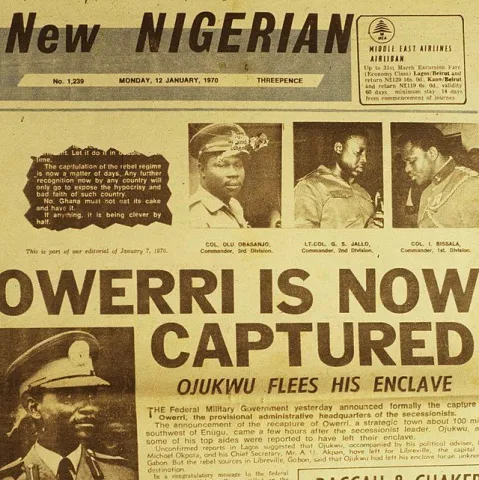Between the Federal Republic of Nigeria and the secessionist state of Biafra, the Nigerian Civil War, also known as the Biafran War or the Nigerian-Biafran War, erupted from July 6, 1967, to January 15, 1970. To prevent the Eastern Region (Biafra) from seceding from the Republic of Nigeria, Nigeria went to war.

The Hausa-Fulani-dominated federal government was too much for the Igbo people of the Eastern Region to bear, and they saw secession as their only option. More than one million people, including children, died in the three-year bloody conflict.
Nigeria’s civil war’s immediate causes.
1. January’s first military coup. The Northerners viewed the 15th of 1966, led by Major Kaduna Nzeogwu, as an Igbo coup. While some Igbo leaders were killed in the coup, prominent Northern leaders like Prime Minister Abubakar Tafawa Balewa, Alhaji Ahmadu Bello (Premier of the Northern Region), and his wife, Hafsatu Bello, were killed. Igbo officer General Johnson Aguiyi-Ironsi was appointed head of state after the coup. Northerners were enraged by this because they suspected fraud. They got ready to take revenge.
2. The counter-coup of 1966. In Nigeria, this was the second coup. On July 29, 1966, a group of Northern military officers, led by Lt. In response to the assassinations of Northern politicians and officers by the coup plotters on January 15, 1966, Colonel Murtala Mohammed staged a coup. Northerner General Yakubu Gowon was installed in power as a result of this coup. Regaining control was a success for the North.

3. Igbos living in northern Nigeria were massacred, which was the third direct cause of the Nigerian civil war. Tension among Igbos in Northern Nigeria increased following the first and second coup, which were perceived as ethnic conflicts. The pogroms directed at Igbos were the result of this tension’s climax. Over a million Igbos fled to the Eastern Region between June and October 1966 as a result of pogroms in the North, which killed between 8,000 and 30,000 people, half of whom were children.
4. The Federal Military Government of Yakubu Gowon divided Nigeria’s four regions into twelve states in May 1967 to promote national unity. The former Eastern sector commanded by Lt. Col. The establishment of the state (without consent) was the final straw, according to Chukwuemeka Ojukwu. As a result, on May 30, 1967, Lt. Col. The Biafra Republic’s declaration of existence and independence was made by Ojukwu.
Beginning of the Nigerian Civil War.
The secession of the Eastern Region as Biafra should be resisted, the Federal Military Government ordered in response to Ojukwu’s actions. The Nigerian federal troops entered Biafra in two divisions on July 6, 1976. Division 1, under the command of Col. While the second Division made its way toward Nsukka, which was taken on July 14, 1966, Shuwa conducted operations throughout Biafra’s northern region.

The Biafran army struck the western part of Nigeria on July 9 in retaliation. On August 21, they marched across the Niger River, passed through Benin City, and then stopped at Ore. Lt. Was the attack’s mastermind. Col. Yoruba man named Banjo holds the Biafran rank of brigadier. After some resistance from soldiers stationed there, the Biafran troops managed to take control of the Midwest.
Gowon and Col. Were both incensed by this. Muhammad Murtala created Division 2 in order to expel the Biafran army from the midwest and then launch an attack on Biafra. On September 20, the Nigerian army took back control of the mid-west region.
The Republic of Biafra’s capital is now Enugu. Aba, Umuahia, and Owerri later served as the Republic’s provisional capitals after Enugu was taken over by Federal forces in October 1967.
The Federal Military Government (FMG) seized Port Harcourt and numerous other coastal oil facilities in less than a year. More than 2 million Biafrans died from starvation and other causes as a result of the Federal Military Government’s blocking of all routes for food importation into the Republic of Biafra.
While many people around the world referred to the food blockade as genocide, the FMG viewed it as a war strategy. Foreign mercenary pilots brought a small amount of food into Biafra, but it was insufficient to end the country’s starvation. Carl Gustav Von Rosen, a notable mercenary who attacked Nigerian military airfields in Port Harcourt, Benin City, and Enugu, was one of the group.
The Biafran War and Nigerian Civil War are over.

Biafrans were attacked by the FMG from the air, land, and sea, rendering them defenseless at one point. By the year’s end in 1969, it was clear that the Nigerian civil war would soon come to an end.
On January 7, 1970, the FMG began its last operation, known as “Operation Tail-Wind.”. The 1st and 2nd Infantry Divisions provided support for the 3rd Marine Commando Division as they carried out the operation. Owerri was taken on January 9th, and Uli was lost on January 11th of the same year.
The self-declared head of state of Biafra, Lt. Col. On January 8, 1970, Chukwuemeka Odumegwu Ojukwu, who was aware of the situation, left the Republic with his family. The Nigerian civil war came to an end on January 14, 1970, when Philip Effiong, Ojukwu’s deputy who remained with the government of Biafra, surrendered to the Federal Government. On January 15, 1970, Philip Effiong officially declared his country’s surrender, bringing an end to the Nigerian civil war.
General Yakubu Gowon declared following the conflict, “The tragic chapter of violence is just about over. The process of racial harmony is just getting started. We have the chance to create a new country once more. My beloved countrymen, we must honor the fallen, the heroes who gave the ultimate sacrifice so that we can create a country that is great in justice, fair trade, and industry. “. 

